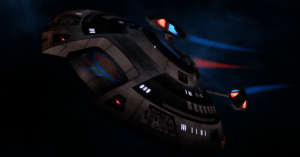USS Aurora
From Star Trek: Theurgy Wiki

| |
| Vessel Name: | USS Aurora |
| Registry: | NCC-72321 |
| Starship Class: | Nova-class |
| Starship Type: | Light Research Cruiser |
| Status: | Active |
| Purpose: | Short-term research missions |
| Constructed: | Utopia Planitia Fleet Yards |
| Commissioned: | September 20th, 2370 |
| Dedication: | Everything is theoretically impossible, until it is done.”
-Robert A. Heinlein |
| Dimensions: |
|
| Mass: | 110,000 metric tons |
| Decks: | 8 |
| Standard Crew Complement |
|
| Cruising Speed | Warp Factor 6.0 |
| Flank Speed | Warp Factor 7.0 |
| Burst Speed | Warp Factor 8.0 (Sustainable for 1 hour) |
| Armaments: |
|
| Defences: |
|
| Auxiliary Craft |
|
The USS Aurora (NCC-72321) was a Federation Nova-class starship assigned to Starbase 39-Sierra in the Alpha Centauri Sector Block.
History
Construction, Launch and Commissioning
As one of the first ships of the Nova-class, closely following the prototype USS Nova (NX-72230) herself, the ‘keel’ of the USS Aurora was laid down at the Utopia Planitia Fleet Yards on February 5th, 2368 alongside those of her sister ships; the USS Anticipation (NCC-72319) and the USS Asimov (NCC-72320). Only two months into the assembly of the primary hull however, a problem presented itself with one of the pre-fabricated modules of the three sister ships. During the construction process of the USS Nova these modules had been built by hand but, for the mass production of the Nova-class ships, the design was copied into pre-fabricated modules that could easily be joined together in the orbital shipyards. One of these modules came with a very miniscule miscalculation that misaligned the secondary deflector on Deck 3 with the primary deflector on Deck 6 by a fraction of an inch. If left unaddressed, this misalignment had the potential to result in a resonance that could negatively impact the performance of the advanced sensor systems which flanked the secondary deflector on both sides. This forced Utopia Planitia to recalculate the design of the entire module and, as they subsequently fabricated entirely new ones, the construction of the three sister ships incurred a delay of several months.

